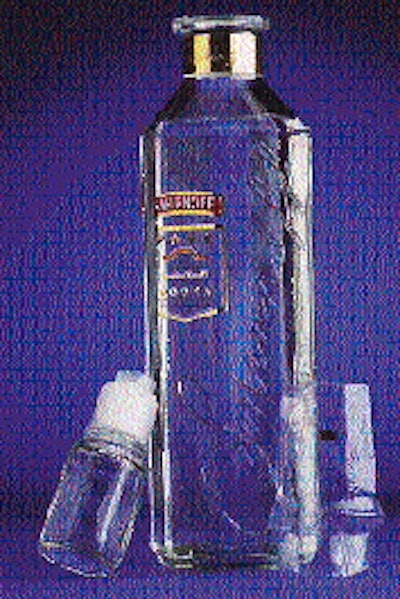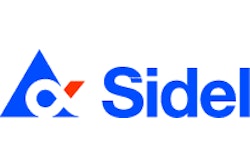A graceful faceted glass decanter with stopper is now defining the gift business for Smirnoff vodka from Heublein, Inc., Farmington, CT. The elegant package was in limited markets for this past Father's Day holiday, but it's really destined to be the gift package for the Christmas holiday season. In the face of declines in U.S. spirits purchasing, this package signals Heublein's commitment to using packaging as a strategic part of marketing. Just about four months separated concept from production of the new package. To produce this package for Father's Day, the distiller leaned hard on the skills of several key suppliers: * The crystal-like glass decanter and stopper are made by the Lawrenceburg, IN, plant of Anchor Glass (Tampa, FL). They were designed by Anchor after viewing the bottle concepts prepared by Heublein. A sizable Smirnoff signature is molded across several sides of the bottle so the brand name is visible even when the decanter is reused. * The glass stopper is fitted with two locking washers that secure in place a synthetic cork, the Cellukork(TM) from Lermer Packaging (Garwood, NJ), one of the first uses on a nationally distributed spirits product. * A clear pressure-sensitive label from Cameo Crafts (Montreal, Quebec, Canada) is the major bottle decoration. The same supplier also furnishes a gold-toned neck label that was added to minimize the visual effect of the white cork in a largely transparent package and product. * A clear polyvinyl chloride shrink sleeve from Templock (Santa Barbara, CA) provides tamper-resistance by bonding the stopper to the neck of the bottle. The 2-mil band is formulated with a UV additive and printed with a registration eye spot. A tear-off perforation is added on the applicating machine. "What we're trying to do is to contemporize the Smirnoff brand while we maintain a very premium image," says Ken Toumey, marketing director for Smirnoff. "The decanter is the packaging component in a program that includes advertising and promotion." Two bottles for one The decanter and stopper were a coordinated effort between Heublein's product and packaging people and the engineering design department at Anchor. The distiller had developed some design ideas, and it was Anchor's task to translate them into a bottle and stopper that could be produced on bottlemaking equipment. "Heublein was really interested in consumer reuse of the container," says Tom Quamma, Anchor's sales representative for the distiller. "They wanted the consumer to be so impressed with the package that he would buy Smirnoff. The crystal-like decanter is so beautiful the consumer will want to reuse it. Even if it's filled with something else, it still has the flowing Smirnoff signature on its side." Presentation was so important to the distiller that it insisted the decanter and the stopper be produced in the same plant, Quamma says, so the flint glass color would be identical in both pieces. The stopper is actually another bottle with a finish. It has to be hollow to run on commercial glassmaking equipment, Quamma says. Heublein would have loved a solid glass stopper. Even if Anchor could make it, Heublein would have been put off by the cost, Quamma says. Tolerances an issue The stopper fit was a major issue for both Anchor and Lermer. Natural cork wasn't an option because of the effect of vodka on it. But the plastic cork, says Quamma, is very unforgiving. Naturally, Lermer points out the wide tolerances that are common with glass. "Glass does sometimes have a problem in maintaining concentricity and accuracy of the bore," says David Collins of Lermer's Ontario, CA, manufacturing facility. "When lightweighting of glass isn't an issue like this decanter, it's often run on less modern equipment where tolerances tend to be liberal." What makes the fit of the stopper so dicey is that it can't be too loose or Heublein and customers will experience leakers. At the other extreme, if the fit is too tight, consumers won't be able to easily remove the stopper. Obviously, neither is desirable. Especially with a tight timetable, both companies had to work together closely. "We ended up sampling the glass with two different neck tolerances," Quamma recalls. "Lermer then produced their cork for both samples. In the end, we built our neck sizes a bit undersize so that we could then vary the iron content in our samples to get the necks just right. "The Lermer technicians applied their cork and, at first, it was too tight. They told us to take one-ten-thousandths out of the neck, which we did by removing some iron from the mix. So we started the neck small and went bigger until we got the stopper to fit with the proper torque." For its part, Lermer was able to vary its foam mixes and densities to provide "squeezability," yet fall within the specifications on leakage and extractability. The Cellukork is secured to the stopper via two plastic locking washers. Although virtually any color cork is possible, Heublein opted for a white cork. "The use of this type of cork presented a whole learning curve for us," says Dick Blanchard. "We had to do extensive tests to determine the correct compression ratios, to learn how much the synthetic material will relax and to keep from having leakers. It's more predictable than natural cork, but it's not as flexible." P-s labels a first Since the product, decanter and stopper are all crystal clear, Heublein "hides" the white cork color behind the gold foil neck band from Cameo Crafts. "With the white cork showing, we felt we lost some elegance in the package," Blanchard states. The neck label is a lamination of 0.00035 aluminum foil and 45# paper that's tinted gold and includes a blind emboss. The same label converter also produces the clear front label and the back label that includes the UPC code. The main label is 2 mils of polypropylene that's printed in two colors by rotary letterpress and two more colors via rotary screen printing. After the gold is hot stamped, the print is protected by an overlamination of 1 mil of polyester. To get the smoothest laydown of the permanent adhesive, Cameo Crafts uses a 1.5-mil liner of polyester. Assembly of the stopper and cork is farmed out to sheltered workshops. And for '95, bottles are labeled under contract. But not for long. Blanchard reports that an automatic p-s label applicator will be brought in-house in January for this job and for other Heublein labels. The overall effect of the finished package was exactly what Heublein wanted. "We thought the resulting package turned out very well," says Blanchard. "The definition of the fluting, the sharpness of the edges was better than we expected." The effect is so strong that focus groups early on-and test market sales-verify that consumers will pay more for the decanter package. In most cases, the decanter is priced $1 to $2 above the price of red-label Smirnoff (80-proof) in the 750-mL size. This allows Heublein to achieve its two other marketing goals as enumerated by Ken Tuomey. "It enables us to sell more in the 750-milliliter size, which allows us a better margin. And it lets us take advantage of incremental sales increases during the holiday season. That is an important time for gift-giving in the spirits business," Toumey says. The major descriptors that came out of the focus groups were "elegant" and "striking." The groups confirmed that the package enhanced the premium image of Smirnoff. Some, mentioning reuse, said they felt the package was so good they wanted to "show it off in my bar." Thus far, sales volume has exceeded expectations, Toumey says. "I'd say we're about 20 percent above our forecasts," he says, "and our forecasts were pretty high."




























